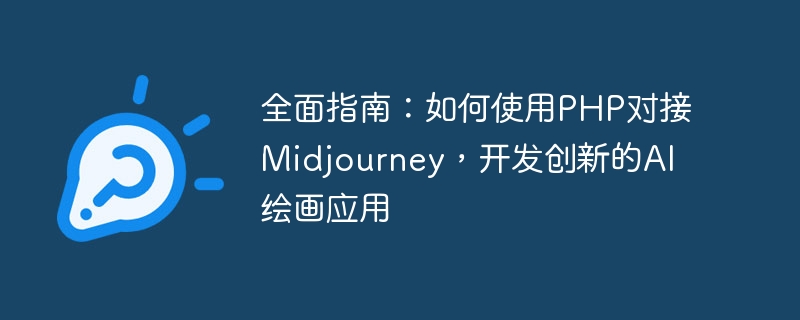

Comprehensive Guide: How to use PHP to connect to Midjourney and develop innovative AI painting applications
Introduction:
With the rapid development of artificial intelligence technology, AI painting applications It has become one of the most innovative and promising fields today. As a leading domestic artificial intelligence technology provider, Midjourney's AI painting API provides developers with powerful painting capabilities. This article will introduce how to use PHP to connect to Midjourney to develop an innovative AI painting application, and provide specific code examples to help readers get started.
Part One: Introduction to Midjourney
Midjourney is a company focused on the development and application of artificial intelligence technology. It provides a series of powerful artificial intelligence APIs, including image recognition, speech synthesis, natural language processing, etc. . The focus of this article is to introduce Midjourney’s AI painting API.
Midjourney's AI painting API uses deep learning and neural network technology to generate very realistic paintings based on input images or text. By connecting to this API, developers can quickly implement innovative AI painting applications.
Part 2: Preparation
Before starting to connect to Midjourney’s AI painting API, we need to do some preparations:
1. Register a Midjourney account: Go to Midjourney’s official website ( www.midjourneycorp.com) to register and obtain an API account and key.
2. Install PHP environment: Make sure that PHP has been installed in your development environment and have certain PHP programming capabilities.
3. Download Midjourney’s PHP SDK: Midjourney provides PHP SDK, which can help us use its API more conveniently. Go to Midjourney’s developer documentation page, download and import the PHP SDK.
Part 3: API docking steps and sample code
Next, we begin to introduce the API docking steps and sample code in detail.
1. Set the API call parameters:
In the PHP code, we first need to set the parameters required for the API call through the following code:
<?php $accessKey = "YOUR_ACCESS_KEY"; $secretKey = "YOUR_SECRET_KEY"; $apiBaseUrl = "https://api.midjourneycorp.com"; $apiPath = "/v1/ai/painting"; ?>
Change YOUR_ACCESS_KEY and YOUR_SECRET_KEY in the above code Replace it with the API account and key you obtained on the Midjourney platform.
2. Prepare input data:
Before calling the API, we need to prepare the input data. For painting applications, we can use images as input. Here is a sample code snippet for loading images into the program:
<?php $imagePath = "YOUR_IMAGE_PATH"; $imageData = file_get_contents($imagePath); ?>
Replace YOUR_IMAGE_PATH in the above code with your own image path.
3. Build API request:
Next, we need to build the API request and send it to Midjourney's server. The following is a sample code snippet for building an API request:
<?php
$apiUrl = $apiBaseUrl . $apiPath;
$headers = array(
"Content-Type: multipart/form-data",
"Authorization: Bearer " . $accessKey,
);
$postData = array(
"image" => base64_encode($imageData),
);
$ch = curl_init($apiUrl);
curl_setopt($ch, CURLOPT_POST, true);
curl_setopt($ch, CURLOPT_POSTFIELDS, $postData);
curl_setopt($ch, CURLOPT_HTTPHEADER, $headers);
curl_setopt($ch, CURLOPT_RETURNTRANSFER, true);
$response = curl_exec($ch);
curl_close($ch);
?>4. Parse the API response:
Finally, we need to parse the API's response data and process it. The following is a sample code snippet for parsing the API response:
<?php
$responseData = json_decode($response, true);
if($responseData["status"] == "success") {
$outputImage = base64_decode($responseData["result"]["image"]);
// 对输出图片进行处理,比如保存到本地或展示给用户
} else {
// 处理API调用失败的情况
}
?>Part 4: Further Development and Optimization
Through the above steps, we have successfully completed the process of using PHP to interface with Midjourney's AI painting API . However, this is just a basic example, and there are many areas that can be further developed and optimized in practical applications.
For example, we can add a user interface to allow users to easily upload pictures for painting. We can also explore other parameter settings, such as choosing different painting styles, adjusting the level of detail of the painting, etc.
In addition, we can also combine other functions, such as image recognition API, to make our AI painting application more intelligent. For example, it can automatically select a suitable painting style based on the content of the input image.
Conclusion:
This article details how to use PHP to connect to Midjourney's AI painting API to develop innovative AI painting applications. By learning and mastering this technology, developers can innovate in the field of AI painting and provide users with a better painting experience. I hope this article can be helpful to readers and stimulate your creativity and development potential. I wish you success on the road to AI painting application development!
The above is the detailed content of Comprehensive guide: How to use PHP to connect with Midjourney and develop innovative AI painting applications. For more information, please follow other related articles on the PHP Chinese website!




